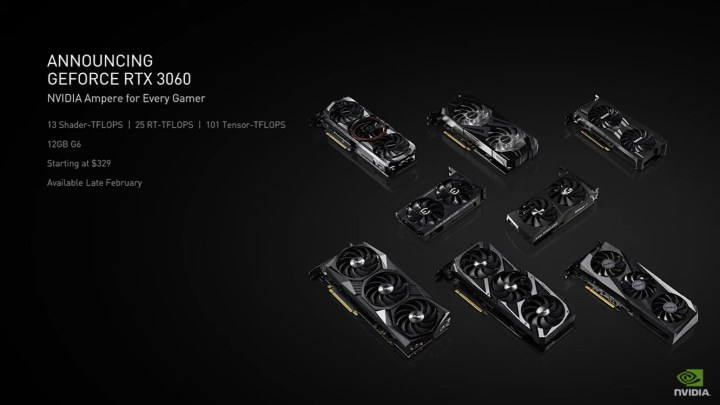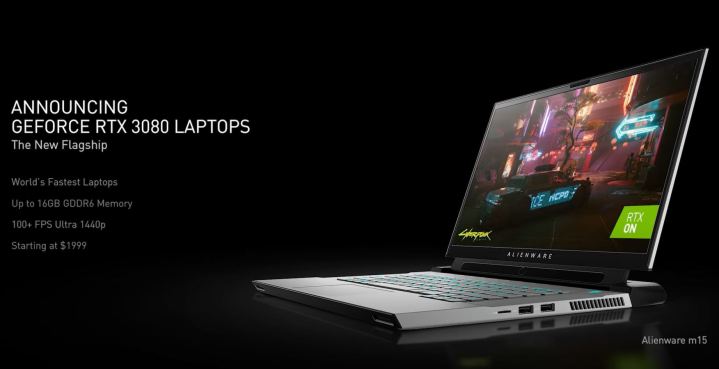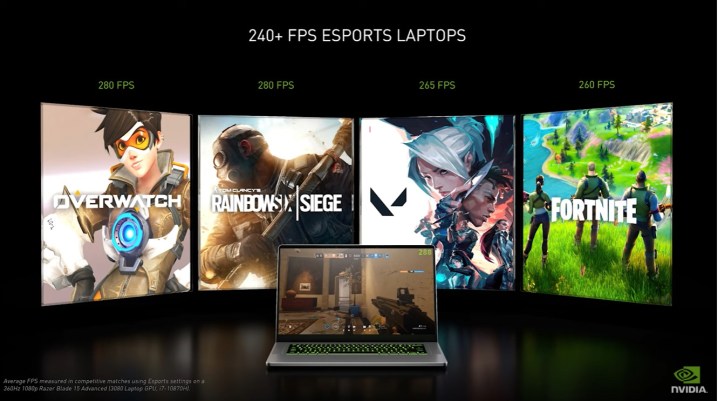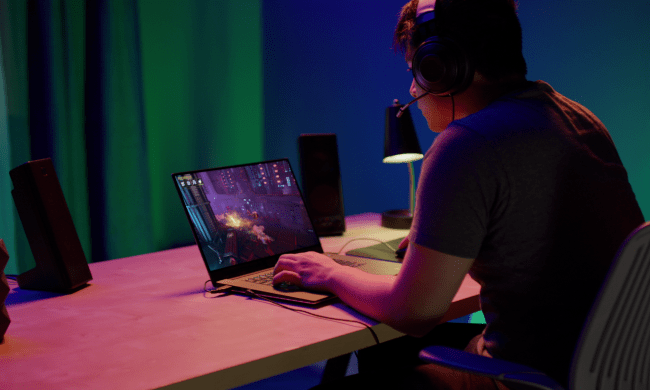Nvidia’s CES 2021 kicked off today, and the company unveiled a number of new products for laptops and desktops. Most notably, Nvidia dropped its new RTX 3000 series architecture, powered by Ampere, to notebooks, delivering more power for mobile gamers who want to play ray tracing titles.
Titled GeForce RTX: Game On, the event was focused on both gamers and creators.

Past and future
Unlike prior Nvidia presentations, CEO Jensen Huang did not helm the company’s CES 2021 announcement. Instead, the prerecorded presentation was delivered by GeForce Senior Vice President Jeff Fisher, who began by recapping the company’s accomplishments in 2020.
Those achievements include the launch of its new Ampere architecture, which provides the second-generation ray tracing cores found on the company’s current GeForce RTX 3000 series of desktops, as well as the launch of its GeForce Now online game streaming platform, which connected 6 million users over 25 global data centers to stream 200 million hours of game play in 2020.

“2020 was an extremely tough year, with no end of challenges,” Fisher said at the beginning of the presentation, noting that as people worked and played from home, Steam gaming increased by more than 40% compared to the prior year. Collectively, he noted, we watched more than 100 billion hours of YouTube videos. The pandemic is also fueling the need for GPUs.
To date, 36 games are now powered by ray tracing, Fisher said, including “the number one battle royale game, the number one RPG, the number one MMO, and the number one bestselling game of all time: Minecraft. And the list continues to grow. DLSS enables new great ray tracing experience in these games by delivering a big performance boost with awesome image quality.”
Nvidia noted that Call of Duty has been the most successful first-person shhooter franchise ever, and ray tracing was supported in 2019 with Call of Duty: Modern Warfare.

The company also announced and demoed new titles, including Outriders, Five Nights at Freddy’s, and F.I.S.T.: Forged In Shadow Torch, all of which will support DLSS and ray tracing.

Other technologies that were highlighted include Nvidia Reflex, which is geared toward e-sport gamers and supported on a dozen games, including seven of the top competitive shooters.

Nvidia also announced that Rainbow Six Siege and Overwatch will both be adopting Nvidia Reflex. Additionally, five new monitors announced at CES 2021 come with Nvidia’s Reflex Latency Analyzer, which the company compared to a heart rate monitor for athletes. These new G-Sync monitors come from Acer, AOC, and Asus.
An RTX for every gamer

As games get more powerful, Nvidia admitted that gamers on its aging GTX platform — specifically the GTX 1060 — could not keep up. To help GTX 1060 gamers get better performance, the company announced its new RTX 3060 at just $329, which brings the power of Ampere and the second-gen RTX cores.
The latest RTX 3060 supports ray tracing and DLSS for 60-frames-per-second (fps) game play, the company said during its presentation. This card is capable of 13 shader teraflops, 25 RT TFLOPs, and 101 tensor TFLOPs. It has 12GB of G6 memory and will be available in late February.
RTX on laptop

“Amazing gaming doesn’t end at the desktop,” Fisher said. After unveiling the entry-level RTX 3060 GPU for desktops, Nvidia also announced that its Ampere architecture is going mobile.
“Today, we are announcing a new generation of Ampere-powered laptops,” Fisher said, adding that they are powered by second-generation RT cores and third-generation Max-Q technologies, “delivering twice the power efficiency of previous generations.”
The new Max-Q design has been redesigned from the ground up.
“Every aspect — the CPU, GPU, software, PCB design, power delivery, thermals — is optimized for power and performance,” Fisher said of the third-gen Max-Q design. “Our third-generation Max-Q technologies use A.I. and new system optimizations to make high-performance gaming laptops faster and better than ever.”

Rather than setting power for the CPU and GPU, A.I. helps to dynamically adjust the power and shift it from the processor, GPU, and CPU memory on a per-frame basis based on where power is needed most, resulting in a larger performance boost than ever before, Nvidia claims. This is part of Nvidia’s Dynamic Boost 2.0 technology.
Nvidia also announced Whisper Mode 2.0, an A.I. engine for better acoustics.
“Whisper mode has been reengineered from the ground up and is custom-built into each laptop at a system level,” Fisher said. “You pick your desired acoustics, and Whisper Mode 2.0 uses A.I.-powered algorithms to manage the CPU, GPU, system temperature, and fan speeds to deliver great acoustics at the best possible performance.”
A new Resizable Bar was also announced, “which leverages the advanced capabilities of PCI Express to boost gaming performance.”
With Resizable Bar, games can access the entire GPU memory for multiple updates at the same time, which helps to improve the performance. He noted that GPU memory can be used for textures, shaders, and geometry, as it constantly updates as the player moves through the game world.
With DLSS, Nvidia claims that the new RTX tensor cores can deliver two times the performance at the same power.
“The GPU needs to calculate almost 4 million pixels for a single 1440p frame,” Fisher explained. “DLSS requires only a fraction of the pixels, which improves efficiency and increases performance. It also delivers more battery life, when you’re gaming on the go.”
Four years ago, Max-Q laptops weighed 9 pounds and were 40mm thick. Today, with the third-gen Max-Q design, Nvidia claims that laptops from its partners are half the size, half the weight, and deliver 10 times the performance of the first-gen design.
RTX 3060, 3070, and 3080 mobile laptops

Nvidia started introducing its mobile RTX 3000 series lineup with the RTX 3060, the entry-level GPU configuration on mobile.
“The RTX 3060 laptop is faster than anything on the market today, including the $2,500 RTX 2080 Super,” Fisher proudly exclaimed. “It’s 30% faster than the PlayStation 5.”
Fisher said the RTX 3060 delivers 90 frames per second on the latest games at ultra settings in 1080p. Meanwhile, RTX 3060 laptop models start at $999.
The midtier model is the RTX 3070, which ups your gaming experience to 1440p.
“Gamers know that 1440p displays with twice the pixels of 1080p provide the perfect mix of high-fidelity graphics and great performance,” Nvidia said. “Yet, they are missing on laptops for years. We’ve been working behind the scenes with display manufacturers and [manufacturers].”
With the RTX 3070 laptops, you’ll be able to play 1440p games at up to 90 fps with ultra settings. It’s also 1.5x times more powerful than Sony’s PlayStation 5, Nvidia said. Laptops with this mobile GPU start at $1,299.

Finally, the 3080 mobile will be the flagship on laptop. Nvidia is positioning as a notebook for gamers and creators.
These laptops come with 16GB of G6 memory and delivers up to 100 fps with ray tracing on. They start at $1,999.
Nvidia announced that more than half of the RTX 3000 mobile laptops will deliver 240Hz or higher refresh rates, which make them ideally suited for e-sports.

“With the performance of our GeForce RTX 3080 laptop GPUs, gamers will be able to play at 240 frames per second across top titles like Overwatch, Rainbow Six, Valorant, and Fortnite,” Fisher said. “And combined with Nvidia Video Reflex, gamers can achieve sub-20ms system latency, enabling them to play their absolute best.”
RTX Studio for creators

For professionals, Nvidia also announced new Nvidia Studio laptops with RTX-powered A.I. that will change the way artists work by helping to make complex edits, such as automatically converting videos from landscape to portrait while keeping the action at the forefront.
“RTX-accelerated A.I. will change the way creators work,” Fisher said. “For example, Adobe Photoshop recently introduced neurofilaments, which use A.I. to quickly make complex edits to photographs. Adobe Premiere Pro Auto-Reframe uses A.I. to convert landscape video to portrait, while keeping the action front and center. In DaVinci Resolve 17, the new Magic Mask feature uses A.I. to speed up mass creation and tracking.”
More than 70 laptops for gaming and professionals will be available starting January 26, the company said. It’s the company’s biggest launch ever.
“These are the world’s fastest laptops,” Fisher said. “They give gamers and creators a huge variety to pick the right device for their needs.”
“RTX is the new standard, and the momentum continues to grow,” Nvidia said.



